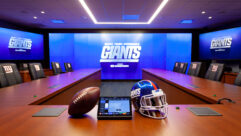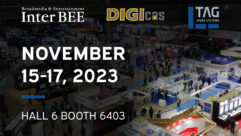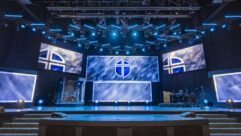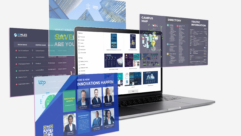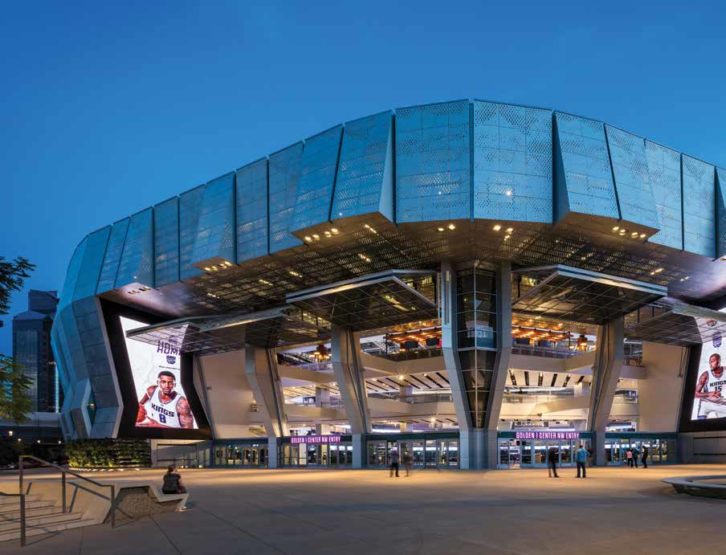
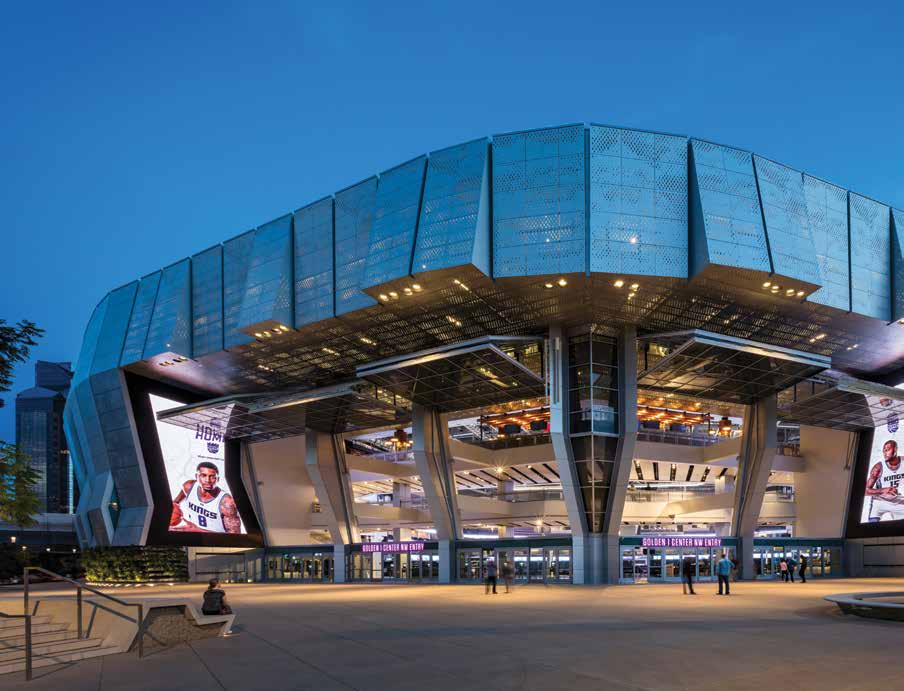
“As of opening night, the Kings did not hire a single person to go from no IPTV to one of the most advanced systems in the NBA,“ explains Eli Garten, VP, IPTV & Enterprise Video Solutions, at VITEC. For Golden 1, that was a priority, but so was guest experience, including synchronization of nearly 800 endpoints; integration between TVs and signage; and a dynamic content platform that could easily evolve as new sponsorship opportunities arose.
VITEC’s EZ TV IPTV and Digital Signage system was a good fit on several fronts. It is based on simple, affordable all-hardware endpoints with no codec license fees or other recurring expenses, delivering broadcast quality, low latency, synchronized HD, and Tier-1 IPTV experience. Operationally, it gave the stadium IPTV and digital signage capabilities from a single platform, with substantial automation to help them to avoid manual effort in preparing and routing streaming and signage for different types of events. EZ TV’s centralized nature also allows the platform to remain as neutral as possible, so content could be “living and breathing” as Garten puts it, able to integrate with a wide range of internal and external sources now and in the future.

That’s because the system, based on VITEC’s long-standing and ever-evolving EZ TV platform utilizes things like HTTP sessions and database polling to drive content. While there is nothing particularly new or revolutionary about this from a technology/software standpoint, conceptually the approach is still not as widespread as you might imagine- -despite the fact that synchronization, timeliness, and flexibility are critical to a modern and dynamic in-stadium experience.
Think about the things that make stadium content weak for the users, and how that relates to the operators’ business case. For example, if the TV above the snack bar is latent, people might not want to get up to buy food (i.e. contribute to revenue); nobody wants to be standing at concessions when a cheer erupts from the stands and they can’t see why. Tenants who are purchasing 7-year leases for the VIP booths aren’t impressed by ’90s hotel TVs with their cumbersome (and fixed) menu interfaces and painful latency. Some percentage of guests want to be on their phone/second screen, but the Wi-Fi can’t handle it, or the app that was custom-built two years ago can’t change and now seems old and kludgy. Backstage, it can take many hours of manual labor to prepare for an event—building food menus, setting up custom channels depending on the tenant, loading in content, routing it etc. Although all these tasks are not difficult in every stadium–and clever operations managers streamline many of them–they are still challenging in many situations.
For decades, with in-stadium content (as with broadcast) the priority was signal path- -getting signal from A to B with maximum quality and reliability, at minimal cost. Whether over RF, fiber, IP or wireless, there has always been a necessary focus on resolution, bandwidth, compression, latency, reliability, serviceability, and cost. It’s a big job to move video and it takes a lot of engineering and expertise.
But it’s just as important to think about what’s in the signal–how it was made or generated, how easy it is to change it, and how it will be experienced by the customer. Will the content system meet the user’s expectations and be fun, interactive, and current? Will it serve the operator’s business case? Adapt to future business cases? Is it inexpensive to run and operate—not just technologically but in terms of its ability to automate and update the content experience? Can it easily take advantage of existing content that is already being built by other partners or experts?
For example, Garten says, the EZ TV system at Golden 1 is fully integrated with Appetize, the leading solution for food sales and inventory, and Legends Hospitality, a well-known food and client service provider. These vendors are already manually maintaining operational databases to reflect the day’s menu and price sheet. They’re removing items that sell out, discounting items that aren’t selling— all the labor that goes into running the information for stadium catering. As Golden 1 completes rollout of the EZ TV system, the caterers’ operational database will be immediately available to every menu board in the stadium, automatically. When the caterer makes a change in their office, the menus will automatically change throughout the stadium.
Here’s another example: operators can utilize the worldwide information gathering that goes on at Stats.com. The popular statistics service can populate wherever the stadium operators want to show it—say a lower third on the signage as an example. These types of content agreements can be templated and automated with continually refreshing content. This allows operators to pull in robust rich content from all over the content universe.
This idea of polling databases for content— rather than reinventing the wheel–is fundamental to EZ TV and part of a system that is designed to centrally manage every screen from a single interface, automating as many of the streams as possible. Again, it’s not a new concept, but one that still has headroom in many public settings.
At Golden 1, EZ TV enables administrators to centrally manage and distribute up to 16 live feeds, 16 unique menu channels,74 TV channels and more than a dozen private feeds generated at the arena’s “Mission Control” area. Administrators can create and schedule video-rich signage for any of the displays–including in the concourse, concessions, and in the suites and lofts—from a single interface.
“They’re not enslaved into the day to day to routine,” Garten says. “So there’s time to innovate.” Garten says event set-up times are greatly shortened. “Our system allows them to create templates for the Kings games, rock concerts, corporate events–it recalibrates the whole stadium. That took us some time to set up over the first two weeks of activation. But now the same guy who was dealing with the RF system is the operator of the entire endpoint system.” This is especially important when you consider that the Kings games only occupy a small amount of the year’s schedule, and the rest of the time the stadium serves guest tenant events.
Supporting the content capabilities are the hardware and Wi-Fi systems. VITEC’s hardware- based IPTV and signage end-points, along with the company’s professional carrier- grade Blade System encoders, provide low-latency 1080p HD playback as well as precise synchronization from display to display. VITEC’s end points can be used for signage or personal TV function eliminating the need to support two different systems for IPTV and signage.
The facility has 755 displays located throughout the concourse, concession stands, VIP clubs, suites, and lofts with dynamic digital signage, live TV channels and streaming of any event. The endpoints on each TV interface with an HTTP session—no software. “The EZ TV server runs on a physical server or virtual machine that can drive up to 5000 concurrent HTTP sessions,” Garten explains, “The endpoints are brainless; they just have to load a website.” VITEC’s 7th generation H.264 codec ensures broadcast quality low latency multicast streaming; a high-res stream and low-res proxy are made simultaneous to accommodate distribution to TVs and mobile devices in parallel.

On the Wi-Fi side, Garten says the Kings invested heavily with Ruckus Wireless (a Brocade company) commissioning some 700-800 access points. “The visionaries at the team knew that they wanted to do mobile delivery,” Garten says. He explains that they signed up with a company to co-develop the mobile app with them so that it could be unique to their team make it unique to their team and able to be updated continuously as content ideas and agreements were developed. “For our part, our encoder supports mobile with a an optimized stream and a less than ó second delay to the devices,” Garten points out, so that would enable live multicast mobile streams, on demand content.” Garten also points out that in addition to simultaneously creating a mobile-friendly stream, the VITEC system doesn’t rely on the phone’s OS for receiving the video. “Because we control the codec we can open it up to multi-cast support and enable our AES content security engine on phones and tablets in real-time. We can substantially reduce the load on the network and eliminate unwanted latency.”
Also on deck for the Kings: a customized iPad app, powered by VITEC EZ TV, to a custom electronic program guide as well as video-on- demand capabilities similar to the ones found at home—a key feature for VIP suites. “Essentially the team needed a base stream for their TVs, reliability, price, digital signage— all traditional requirements,” Garten explains. “But what really sparked their excitement was the advanced capabilities when it comes to non-linear content—ways to use live TV and live game day feed, special experiences for VIPs etc. So we could give them a mature and proven ecosystem, used by many enterprise and broadcasters to give same experience you have with a modern TV and devices. Our API and SDK are flexible enough to support that vision.”


